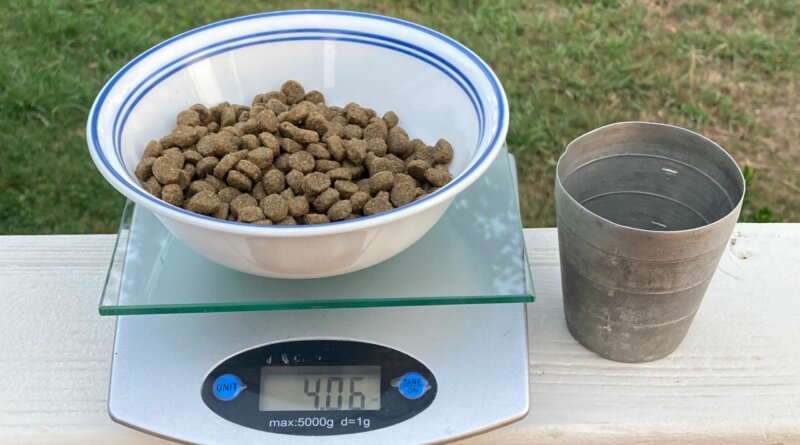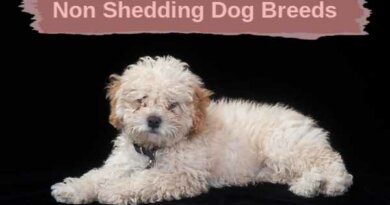How Much Are You Feeding Your Dog?
Ask any owner who feeds kibble to their dog how much they feed to their dog, and you will invariably get the amount expressed in cups: half a cup, one cup, three cups, etc.
When you’re asking someone who has an overweight dog, the question should be more pointed than that: What do you to measure that food? What sort of cup are you using to scoop that food? Veterinarians joke about the “cup” being a 42-ounce Big Culp cup, repurposed from a trip to 7-11, but it’s actually no laughing matter, because the number of calories represented in “1 cup” of various designs varies widely – and this can contribute to a dog’s failure to lose weight. Which of course contributes to every other sort of health problem a dog can have, especially difficulty with mobility as a senior.
Just for fun, I grabbed a few cups from my cupboard, scooped up a “cup” of the kibble I am currently feeding my oldest and youngest dogs. I took a casual scoop; I didn’t shake the food or scrupulously eyeball the how level the amount of food was in each. I then weighed the amount of food in each.

Most of us are aware that most coffee cups in our cupboards contain far more than an actual “cup” of liquid; coffee enthusiasts may drink from mugs that contain two actual “cups” of coffee. The amount of food in each “cup” varied a lot (although I somehow managed to get the exact same amount in each of the two one-cup measuring cups I used).
- White cup 6.46 oz
- Tahoe cup: 8.04 oz
- Aluminum measuring cup: 4.06
- 1 cup measuring cup: 4.06
- 2 cup measuring cup: 4.97
Even with what I guessed was the most accurate tool for measuring accurately, the aluminum measuring cup that has no potential “extra” room at the top (like the glass measuring cup does), it’s possible to scoop with a certain amount of variation.
- aluminum measuring cup filled level 4.06
- aluminum measuring cup, heaping 4.66
Kibble size and shape matters, too! It also makes a difference whether you shake or tap the cup after scooping, making all the kibbles shift in order to compact themselves more tightly.
For all of these reasons, a cup is really a terrible way to measure how much we feed our dogs and how we express that amount to our veterinarians, who not only have to interpret what we might mean when we say “cup” but also have no idea of the calorie content of the food we are feeding.
I looked at the calorie content of just a random few foods from WDJ’s searchable dry dog food database and found quite a variety of calories found in regular dog foods (I didn’t look at any of the Weight control” or “lite” foods), from 340 kcals/cup in Solid Gold’s Wolf King Bison & Brown Rice Recipe Large Breed Adult Dry Dog Food to 522 kcals per cup in Dr. Tim’s Ultra Athletic Fusion Formula.

Some of the dog food companies avoid expressing the caloric content by “cup.” I noticed that Lotus doesn’t offer calories per cup on their label; they cite the more precise calories per kilogram of the food. This is accurate –but how many people will do the math to convert a kilogram of food to ounces or cups? The Dr. Tim’s food mentioned above cites the calories per cup, but they also offer, in parentheses, the number of grams of food that are in their “cup.”
However, the calories are expressed on different dog food labels, when it comes to “Suggested Feeding Amounts,” everyone uses cups! And these amounts are always excessive. The first thing I tell people when I see that they have an overweight dog and they try to defend themselves by saying, “I’m just feeding what it says on the label!” is that the suggestions are just that – suggestions! – and that of course the companies want you to buy twice as much food as your dog really needs!
Honestly, I don’t use calories or cups to determine how much food I give my dogs. If they start looking chunky, or the scale at the vet’s office proves that they are heavier than they were the last time we were there, I scoop a little less for each feeding. If their ribs start feeling a tad too prominent, I scoop a little more. But I am super conscious of their look and feel; I want to see nicely defined waists (when viewed from above) and be able to feel their ribs easily. I shouldn’t need to use a lot of pressure to determine whether they have ribs at all!
If you have to really dig to find your dog’s ribs, or if he resembles more of a tube than an hourglass when viewed from above, I’d strongly recommend that you get yourself a smaller cup, and scoop a little less!




